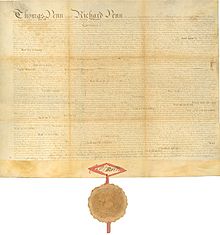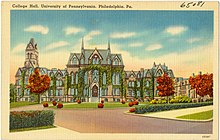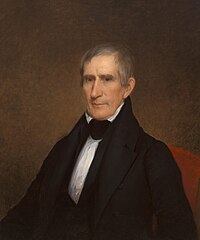School of Arts and Sciences at the University of Pennsylvania
| University of Pennsylvania Higher of Arts & Sciences | |
|---|---|
 | |
| Location | |
 | |
| Philadelphia, Pennsylvania United States | |
| Data | |
| Type | Private |
| Established | 1740 (1740) |
| Dean | Paul D. Sniegowski |
| Number of students | half dozen,400 undergraduates (Fall 2018) |
| Affiliations | University of Pennsylvania |
| Website | world wide web |
The University of Pennsylvania College of Arts & Sciences is the oldest undergraduate college at the University of Pennsylvania, a private Ivy League university, situated on the university'south main campus in University Urban center, Philadelphia.[ane] The college traces its roots to the establishment of a secondary school known as Unnamed Charity Schoolhouse in 1740. In 1749, Benjamin Franklin and twenty-i leading citizens of Philadelphia officially founded a secondary school named Academy of Philadelphia.[2] In 1755, the secondary school was expanded to include a collegiate division known as College of Philadelphia. The secondary and collegiate institutions were known collectively as The Academy and College of Philadelphia. The higher received its charter from Thomas Penn and Richard Penn.[i] Penn CAS is the oldest establishment of higher learning in the state of Pennsylvania and the sixth-oldest chartered college in the Usa.
Penn is distinctive for its comprehensive "One University Policy," which allows students to enroll in classes in whatsoever of Penn's twelve schools, including the police schoolhouse and the Wharton School.[3] The college is the 13th most selective undergraduate school in the United States and 6th most selective in the Ivy League having accustomed only 8.39% of its applicants for the Form of 2022.[4] [5]
History [edit]
The Penn College of Arts & Sciences was preceded by 2 schools, the Charity School and the Academy of Philadelphia. Initially organized past the founder of Methodism, George Whitefield, as "Clemency School," a secondary school known as "Academy of Philadelphia" was eventually founded by Benjamin Franklin in 1749, and was expanded to include a collegiate partitioning known as "College of Philadelphia" in 1755 when it obtained a charter from Thomas Penn and Richard Penn in 1755.[one] Due in role to the influence of early Methodism'south religious leaders, the higher was based in George Whitfield's "New Building", on Ninth Street in Center City, Philadelphia.[i]

Charter of the College of Philadelphia (University of Pennsylvania) in 1755
Benjamin Franklin served as the institution's get-go president until 1755, and continued to serve as a trustee until his death in 1790. Dissimilar other Colonial American colleges at the time, which educated young men for the Christian Ministry, the Penn College of Arts & Sciences was innovative in that it was founded as a nonsectarian establishment meant to train students for leadership in business concern, regime and public service.[half dozen] However, Penn'southward get-go Provost, William Smith, turned the curriculum back to religious channels later succeeding Franklin. The first class graduated in 1757.[one]
In 1765, John Morgan, a graduate of the Class of 1757, established a medical college at the school, now known equally the Perelman Schoolhouse of Medicine, which was the first medical schoolhouse in the United States.

By the showtime of the American Revolutionary State of war, the higher had already educated some of the nation'south foremost political leaders, including James Wilson, Founding Father and the get-go Associate Justice of the Supreme Court of the United States; Francis Hopkinson, Founding Male parent and the first judge of the United States District Court for the Eastern District of Pennsylvania under General George Washington; and Hugh Williamson, Founding Father, and author of several of the 'Letters of Sylvia.[1]
With the successful Treaty of Paris in 1783, the domestic situation was stable enough for the higher to resume classes. The higher was briefly chartered as a state institution and earned its current name, the University of Pennsylvania, when the University was made individual in 1791.[1]

Having been domicile to the Continental Congress in College Hall since 1778, the higher moved to the President's Firm on 9th and Anecdote Streets in 1802.[ane]
Under the leadership of Provost Charles Janeway Stille in 1872, Penn relocated a second time to Almshouse farm west of Philadelphia's Schulykill River, its present site. Over the next two decades, the university began re-orienteering itself to Benjamin Franklin's original aims of discovery and invention, with the Graduate Schoolhouse of Arts and Sciences existence founded in 1882, and the first Ph.D. in Physics honour in 1889 under the provostship of William Pepper.[2]

Transforming itself into a modern research institution, the academy established a number of professional schools, including the Law Schoolhouse in 1850, the Schoolhouse of Engineering and Practical Sciences in 1852, and the School of Dentistry in 1878. The world's beginning, collegiate school of business organisation, the Wharton Schoolhouse was founded in 1881 by an endowment from Joseph Wharton. The School of Veterinary Medicine and the Schoolhouse of Pattern were subsequently founded in 1884 and 1890, respectively.
Penn was too a leader in educational accessibility, and embraced the diversity of America during this period. Among the Ivy League Universities, it was one of the get-go to admit students of colour in 1879. Women were admitted to the graduate school since 1882, and the first women undergraduates at Penn were enrolled with the establishment of the School of Instruction in 1914.[2]
Penn Higher of Arts & Sciences today [edit]
Academics [edit]
Penn College of Arts & Sciences is known for its rigorous liberal arts curriculum, a serial of mandatory classes and distribution requirements that form the eye of the college students' bookish feel. The Full general Pedagogy Curriculum is based on the following:[7]
| Course | Semesters Required |
|---|---|
| Foundational Approach - Writing A year-long intensive seminar that develops students' writing skills, taken in the freshman twelvemonth. | ane |
| Foundational Arroyo - Strange Language A distribution requirement intended to instill at to the lowest degree an intermediate level of a foreign language. | four |
| Foundational Approach - Quantitative Data Assay A course in mathematical or statistical assay of quantitative data. | 1 |
| Foundational Approach - Formal Reasoning and Assay A course that focuses on deductive reasoning and the formal structure of human being thought. | 1 |
| Foundational Arroyo - Cantankerous-Cultural Analysis A form that inculcates in the students the power to empathize and translate the cultures of peoples with histories unlike from their own. | ane |
| Foundational Approach - Cultural Diversity in the U.S. A grade that develops students' ability to examine issue of variety with a focus on race, ethnicity, gender, sexuality, class and religion. | 1 |
| Sector of Knowledge - I. Society A distributional requirement designed to instill structure and norms of gimmicky human society. | ane |
| 'Sector of Knowledge - 2. History and Tradition A distribution requirement focusing on studies of continuity and change in homo thought, belief and action. | ane |
| Sector of Knowledge - III. Arts and Letters A distribution requirement encompassing the means and meaning of visual arts, literature and music. | one |
| Sector of Cognition - IV. Humanities and Social Sciences A distribution requirement combining methods and approaches of works in the humanities and the social sciences. | one |
| Sector of Knowledge - V. Living Earth A distribution requirement dealing with the development, development, construction and office of living systems. | 1 |
| Sector of Knowledge - VI. Physical World A distribution requirement focusing on the methodology and concepts of concrete science. | 1 |
| Sector of Knowledge - Seven. Natural Sciences and Mathematics A distributional requirement focusing on diverse approaches to the natural sciences and mathematics. | 1 |
The strange language requirement, however, may be skipped if the pupil passes a placement exam or demonstrates an acceptance standard of proficiency. Most students graduate inside four years with a Bachelor of Arts degree, although twenty% of students enroll in one of Penn'due south most selective dual caste programs with The Wharton School (B.A - B.Due south. in Economics), Penn Police (B.A. - J.D.), The School of Nursing (B.A. - B.S.North.) or the Engineering Schoolhouse (B.A. - B.S.).
Campus [edit]

Fisher-Bennett Hall, home to the faculties of English, Music and Movie theatre Studies
The College's facilities are located on the University of Pennsylvania's University City campus, especially in College Hall, which houses its administrative and admissions offices.[8]
Van Pelt Library, the University of Pennsylvania'due south main library, is home to more than 2,481,000 volumes, xiii,000 current serial subscriptions, and approximately 1.five million microforms. The collection of the University of Pennsylvania Library Organisation consists of more than than vi.19 million volumes held in 15 specialized libraries as well as a digital library.[9]
Students at the Penn College of Arts & Sciences are guaranteed campus housing for four years. Residence halls, which likewise business firm undergraduate students of Penn'south Wharton School, Nursing School and Engineering science School are either located on the University City Campus. Freshmen are housed on the celebrated main quad, which was built in 1894.
All offset-year students, including transfer students, are required to enroll in a residential dining programme, which offers all-you lot-can-eat meals in Penn'southward five dining halls: the 1920 Commons, Loma Business firm Eatables, English Firm Commons, Mcclelland Limited, and New College House Commons.
Governance [edit]
The College is a school within the Penn School of Arts & Sciences. Every bit of Leap 2018, Professor Steven J. Fluharty is the Dean of the School. Professor Dennis DeTurck stepped downwards as Dean of the College in Hall 2017 and was succeeded past Professor Paul D. Sniegowski. The students of Penn College of Arts & Sciences elect representatives to the undergraduate council, which comprises members from each of the four undergraduate schools at the University of Pennsylvania.
Noted people [edit]

Many eminent individuals have attended or taught at the Higher of Arts & Sciences or the Academy and College of Philadelphia, its predecessor. Among prominent College people were Founding Fathers of the United States Benjamin Franklin, James Wilson, Benjamin Blitz, George Clymer, Robert Morris, Francis Hopkinson and Thomas McKean. Other important figures include Presidents William Henry Harrison and Donald Trump, Supreme Courtroom Justice Owen Roberts, Academy Honour Winner John Legend, NBC News Chief Strange Affairs Contributor Andrea Mitchell and Tesla Founder Elon Musk.
References [edit]
- ^ a b c d e f g h "Penn in the 18th Century, University Archives, University of Pennsylvania University Archives". www.archives.upenn.edu . Retrieved 2018-06-15 .
- ^ a b c "A Brief History of the University, University of Pennsylvania University Archives". www.archives.upenn.edu . Retrieved 2018-06-15 .
- ^ Meyerson, Martin (January 29, 1973). "Report of the University Development Commission" (PDF). upenn.com . Retrieved June xvi, 2018.
- ^ "Penn admits a record-low 8.39 percentage of applicants to the Form of 2022". thedp.com.
- ^ "Top 100 - Lowest Credence Rates".
- ^ "Penn'due south Heritage | University of Pennsylvania". www.upenn.edu . Retrieved 2018-06-15 .
- ^ "General Didactics Curriculum | College of Arts & Sciences - University of Pennsylvania". world wide web.college.upenn.edu . Retrieved 2018-06-15 .
- ^ "College Hall". University of Pennsylvania Facilities and Real Estate Services. 2012-12-xx. Retrieved 2018-06-15 .
- ^ FACTS2017mar2018.pdf - Penn Libraries Selected Facts (PDF). University of Pennsylvania. 2017. p. 6.
External links [edit]
- Official website
Coordinates: 39°57′N 75°11′West / 39.95°N 75.19°Due west / 39.95; -75.19
Source: https://en.wikipedia.org/wiki/University_of_Pennsylvania_College_of_Arts_%26_Sciences
Postar um comentário for "School of Arts and Sciences at the University of Pennsylvania"